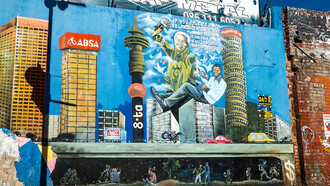In government offices across the nation can be found an “Active Shooter Event Reference Guide.” This helpful pamphlet is courtesy of the U.S. Department of Homeland Security. The guide describes an active shooter as “an individual attempting to kill people in a confined or populated area; in most cases, active shooters use firearms and there is no pattern or method to their selection of victims.” Yes, it has come to the point where the entirety of American society must fear and protect itself from other Americans. That it has come to this is no surprise to those who know and understand U.S. history.
In 1967, H. Rap Brown, Chairman of the Student Nonviolent Coordinating Committee (SNCC) proclaimed, “Violence is part of American culture. Violence is as American as cherry pie.” Brown was right on. America was born of institutional violence. First, genocide was committed against the indigenous of the land colonized by European immigrants. Second, the nation’s economy was built on the brutal and violent system of enslavement. Third, the expansion of the country occurred through violence not just to the indigenous but to others; i.e., the indigenous of Mexico (one example, the Mexican American War). Institutional violence is deeply rooted in the American culture.
The Active Shooter Event Guide warns that victims are selected at random and that the event is unpredictable and evolves quickly. However, “targeted group violence” has historically been directed toward “the other” in the United States. Victims were selected and targeted because of their race, ethnicity, or religion.
Lynching was a systematic feature of race relations in the United States after 1865. Between 1882 and 1930, on average, a black man, woman, or child was murdered nearly once a week, every week, by a white mob. The lynching of blacks was a persistent manifestation of American culture until the mid-1930s. Targeted group violence directed toward black communities was pervasive during the early part of the 20th century. In 1917, in East St. Louis, a white mob, joined by the police, beat and shot men, women, and children. Black homes were robbed and set ablaze. In 1919, known as the “red summer,” race riots occurred in more than three dozen cities when whites attacked blacks and burned their homes. The first firebombing of an American city did not occur during 9-11 but in 1921 when pilots dropped incendiary devices on the Greenwood community in Tulsa, Oklahoma. Targeted group violence has not only been directed at blacks. Mexican Americans were targeted in 1943, when several thousand soldiers, sailors, and civilians raged through the streets of Los Angeles, beating every Latino they could find. There are countless examples of targeted group violence that have occurred in our nation’s history.
Violence in America is like a cancer that has metastasized. Targeted group violence has long been acceptable to the majority of Americans; there has seldom been any national denunciation. White America refused to look at the roots of the violence, and the cancer grew. There was no national interest in protecting the lives of “the other”; public opinion was not empathetic or compassionate. A culture of silence prevailed. Targeted group violence disappeared from sight; it was never entered in our history books.
Like cancer cells that grow abnormally and spread uncontrollably to other body parts, the violence that was localized to specific segments of American society -- “the other” -- is now no respecter of race, ethnicity, or age. The cancer of violence has now come to everyday Americans. No one is safe in concerts, workplaces, theatres, shopping malls, churches, or schools…where we send our children daily. First it was the Emmett Tills, now the violence has entered Columbine, Sandy Hook, Parkland. The popular culture in America glorifies violence. Video games, movies, and songs perpetuate the culture of violence. The lack of empathy demonstrated toward the other in institutional and targeted group violence has morphed into a culture of bullying in our schools. We wonder why bullying is epidemic in our nation -- its roots lie in our culture.
How do we stop the violence?
The Active Shooter Guide states that we have three options in an active shooter event: running, hiding, or fighting (last resort). Perhaps there is another way to stamp out the cancer of violence in American society, a much more encompassing and effective way. First, acknowledge the roots of the cancer and print it in our history books, make it part of our conversations. Second, violence directed toward any group in this nation must receive the disapproval of public opinion nationally in our news media; and it must be reflected in our educational system and in the statements of our religious and political leaders. Third, we must have the courage to demand that the glorification of violence be removed from our popular culture. We must stop the sale of violence to our children. Fourth, our acceptance of violence is implicit when there is no empathy for all victims. As a nation, developing the sense of empathy and compassion for all Americans has been missing.
The questions remain: Can we Americans look critically at our culture? Do we have the will to change our culture? Can we understand the connection between selective empathy and the desensitization to violence in a society? Do we understand that none are safe if some remain targeted for violence because of race, ethnicity, or religion?















